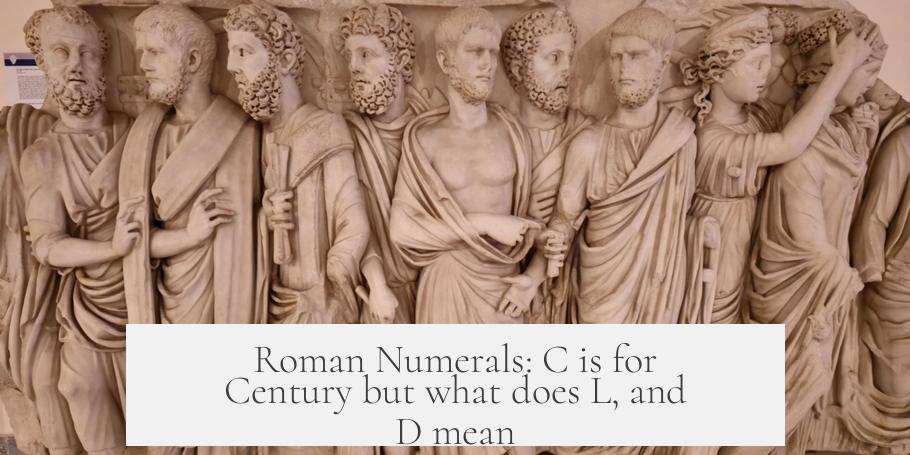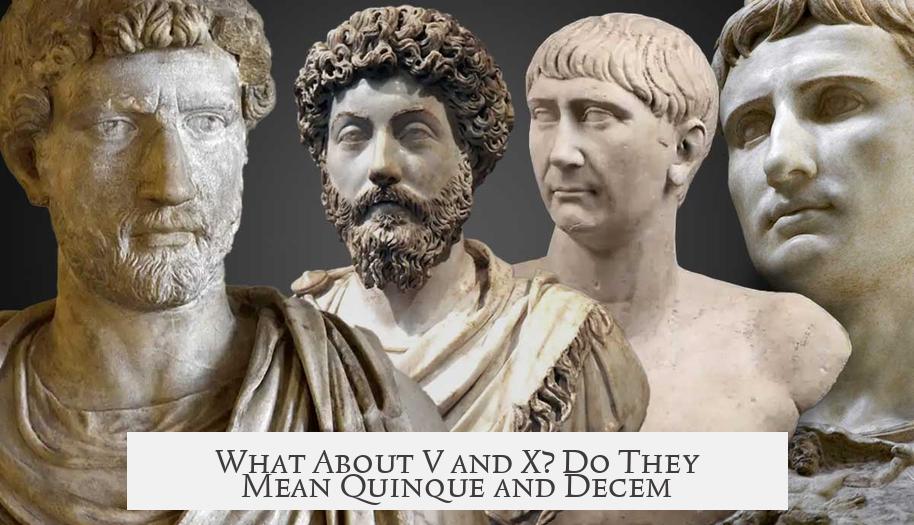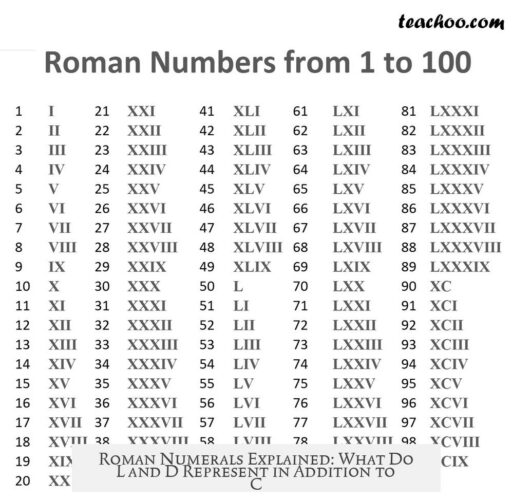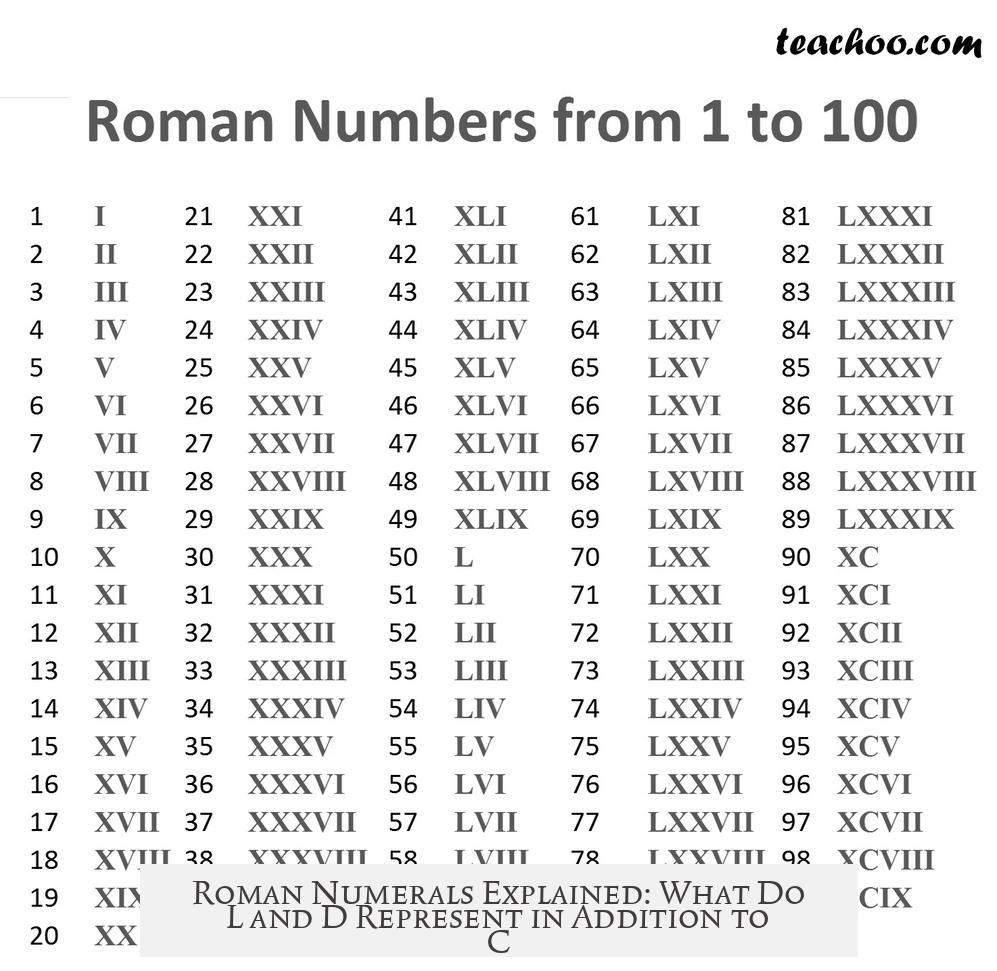Roman numerals C, L, and D represent specific values rooted in historical symbol evolution rather than direct linguistic abbreviations. C stands for 100, L for 50, and D for 500. These symbols derive from earlier numeral forms used by the Etruscans and Romans, with L and D evolving as halves of symbols representing higher values.
Roman numerals originate from ancient counting systems rooted in the early Italic peoples, including the Etruscans. These numerals use combinations of letters from the Latin alphabet to indicate values. While people often associate C with “century” or “centum” meaning 100 in Latin, this is a later interpretation. The actual origins of these symbols are graphical and functional rather than verbal.
To understand what L and D mean in Roman numerals, it is necessary to explore their etymology and graphical development:
- L (50): The symbol L is a simplified form derived from an older symbol representing 50. Initially, the numeral for 100 was represented by a symbol resembling an X with a vertical line through its center. This symbol is attested in Etruscan inscriptions. When this 100 symbol was bisected lengthwise, one half represented 50.
- This half took the form of a three-pointed shape, somewhat like a trident, which then evolved over time into the symbol L. This evolution highlights the practical approach the Roman numbering system took—splitting larger symbols into halves or parts to represent intermediary values.
- D (500): The symbol D also evolved from a larger numeral signifying 1000. The original 1000 was depicted by a circle with an X through it. This symbol was quite elaborate, resembling what we might describe as a Ð (a D with a diagonal line).
- When halved, this 1000 symbol produced a form that simplified into the letter D, which then came to mean 500. This reflects the consistent Roman numeral logic of physically dividing symbols to denote halves and quarters.
- C (100): The letter C, representing 100, originated as the simplified form of the X with a vertical line through it (the original 100 symbol).
- This symbol’s graphical form was reduced over time to a shape resembling a curved bracket or parenthesis-like figure, eventually standardizing as the letter C. Interestingly, the Etruscans first used this symbol, indicating C did not originally stand for the Latin word “centum.”
The logic behind this system also applies to other numerals:
- V (5) derives as the top half of the X (which signifies 10).
- X (10) is a full cross shape with no derived subdivisions; it’s a foundational numeral.
- M (1000) has multiple early variants, including a circle with an X through it. The letter M (from the Latin “mille”) only became the standard symbol for 1000 later in history.
It is important to note that the Roman numerals do not function as abbreviations for the Latin words of their values. For example, V and X do not literally mean “quinque” (5) or “decem” (10) through linguistic abbreviation. Instead, they are more accurately understood as graphical symbols representing quantities. The symbolic system follows a pragmatic design rather than a strictly linguistic one.
| Numeral | Current Symbol | Origin and Meaning |
|---|---|---|
| 50 | L | Half of the original 100 symbol (X with a line), simplified from a trident-like shape. |
| 100 | C | Simplified form of X with a vertical line; originally Etruscan symbol, not literally “centum.” |
| 500 | D | Half of the 1000 symbol (circle with X), transforming from a Ð-like figure into D. |
This structure reflects a general Roman numeral hierarchy:
- The base numerals 1, 10, 100, and 1000 have their own fundamental symbols.
- The numerals 5, 50, and 500 come from physically halving these base symbols.
- Symbols evolved graphically over time for easier writing and recognition.
In summary, L and D represent 50 and 500 through their origins as halves of larger symbols indicating 100 and 1000, respectively. C stands for 100 and developed from a stylized version of the original 100 symbol. The Roman numeral system’s design emphasizes visual division and symbol simplification, not direct verbal abbreviation.
- L (50) derives from half of the 100 symbol — originally a trident-shaped form simplified to L.
- D (500) stems from half of 1000, a complex symbol reduced to D.
- C (100) evolved from a crossed X figure used by the Etruscans, not directly from the Latin word.
- Roman numerals use graphical representation rather than literal word abbreviation.
- The system reflects halving and subdivision of symbols from base values of 1, 10, 100, and 1000.
Roman Numerals: C is for Century but what does L, and D mean?

If you think Roman numerals are just some fancy letters with random meanings, think again. The letter C stands for 100, yes, often linked to the word century, but L and D have fascinating origins too, deeply rooted in ancient symbolism rather than just letters. Let’s take a stroll back in time and unravel where these numerals actually come from and what they truly mean.
People often associate C with “century,” L with “50,” and D with “500,” but these aren’t just random assignments or shortcuts from Latin words. Roman numerals evolved, borrowing ideas from the Etruscans and earlier civilizations, where numbers took symbolic shapes that were practical and visual rather than alphabetic.
Now, here’s a juicy tidbit: the Roman numeral L, which means 50, didn’t start off as the letter L. Instead, it began as a three-pointed trident-like symbol that was derived from slicing an earlier symbol for 100 in half. That earlier symbol looked like an X with a vertical line running through it—a design found in Etruscan inscriptions.
Imagine you have a big X with a sharp line through the middle. If you cut that symbol in half vertically, what do you get? A trident shape that later eased into the simpler, cleaner L we now know as 50.
The story behind C (100) is just as interesting. That X with a line down was gradually simplified to something akin to parentheses facing each other like )|( and then finally morphed into the letter C. But—and this is important—C does not stand for centum in the original sense. The Etruscans used it long before Latin took over and assigned their own meanings later. So, C as a symbol is older and more symbolic than just the Latin word for 100.
Moving up to D, representing 500, the story ties back to the symbol for 1000, M. Early on, 1000 was depicted as a circle with an X crossing through it. This was a durable symbol that stuck around for a while even before the M from mille came into play. Now, if you slice that circle with an X vertically, you end up with something resembling a capital Зlike a D with a line through it. That half-symbol is exactly how D, the numeral for 500, came to be.
So, the takeaway here is that Roman numerals weren’t randomly chosen letters. They are relics of an ancient numeric system where visualization and halves played a vital role. Five, fifty, and five hundred didn’t just get alphabetic initials but evolved from representations of splitting whole symbols in half.
What About V and X? Do They Mean Quinque and Decem?

Here’s a common misconception busted: V doesn’t literally stand for quinque (five), nor does X stand for decem (ten). These letters started as symbols disconnected from the literal words. For instance, V is believed to be the top half of the X symbol. This is probably because the X could mean 10, and V, as its half, symbolized 5 in a simple, visual way.
This insight reshapes how we look at Roman numerals. Instead of seeing them as abbreviations of Latin numbers, we picture them as shapes derived from older numeric concepts inherited from cultures like the Etruscans. The shape first, the word second.
Why Does This Matter?

Understanding this brings a fresh perspective to everything from historical documents to clocks and movie credits. The next time you glance at a clock showing the time as “LIX,” you’ll appreciate that L, representing 50, isn’t just a letter thrown in—it’s half of a 100, literally split and simplified ages ago. D at 500 is a half symbol of 1000, showing an elegant economy in the numeral system.
Here’s an interesting practical tip: next time you encounter Roman numerals, try to imagine the symbol as a shape rather than a letter. For example, picture the circle with an X when you think of 1000 (M), then imagine slicing that symbol in half to get D. This makes learning and recalling Roman numerals easier—more like decoding an ancient puzzle.
Quick Symbol Evolution Recap

- 50 (L): Half of the 100 symbol (an X with a line down the middle), originally a trident shape.
- 100 (C): Simplified from the same X with a line, evolving into a shape like )|(. This ultimately became C.
- 500 (D): Half of the 1000 symbol, originally a circle with an X. When halved, this became the Ð shape, which evolved into D.
- 1000 (M): Started as a circle with an X through it and later standardized as M, from Latin mille.
This appreciation for the form and history of Roman numerals can make learning them more intuitive and a bit less intimidating for many. They’re not just static letters but living history inscribed in symbolism, halves, and shapes.
Final Thought: Can This Change How We Use Roman Numerals Today?
Maybe it should! While most of us stick to traditional use (clocks, rights numbers, or movie sequels), this deeper understanding encourages us to see Roman numerals as an artistic and practical system rather than mere letters. Whether you’re a history buff, a student, or just curious, knowing the roots of L and D can transform your view. Maybe next time you write “L” for 50, you’ll secretly smile, knowing it’s a trident symbol cut in half centuries ago.
So, is there more to these symbols than meets the eye? Definitely yes. And the next time someone tells you the Roman numeral system is just about letters, you can charm them with the real story behind L and D. Now, that’s a conversation starter!
What does the Roman numeral L stand for and where does it come from?
L stands for 50. It originated from the symbol for 100, which was an X with a vertical line down the middle. When this 100 symbol was cut in half, it formed a trident shape that evolved into the letter L.
How did the symbol D come to represent 500 in Roman numerals?
D comes from halving the symbol for 1000. The original 1000 was a circle with an X inside, which resembled a Ð when cut in half. This half-symbol later became the letter D for 500.
Why is C used for 100 and not directly linked to the word ‘centum’?
C represents 100 but doesn’t come from the Latin word centum. It evolved from a mark resembling )|( originally seen in Etruscan inscriptions before Latin usage. So, the symbol’s origin is older than its Latin meaning.
Do the letters V, X, and C literally mean the numbers five, ten, and one hundred?
No. These symbols do not directly stand for quinque (5), decem (10), or centum (100). They are graphical symbols that evolved independently and only later got associated with their number values.
What was the original symbol for 50 before it became L?
The original symbol for 50 was not L but a three-pointed shape resembling a trident, derived by cutting the 100 symbol in half. Over time, this trident simplified into the letter L.
How did the Roman numeral M for 1000 develop?
M stands for 1000 but came later. Early versions of 1000 were a circle with an X inside. Eventually, M from the Latin word ‘mille’ became the standard symbol for 1000.




